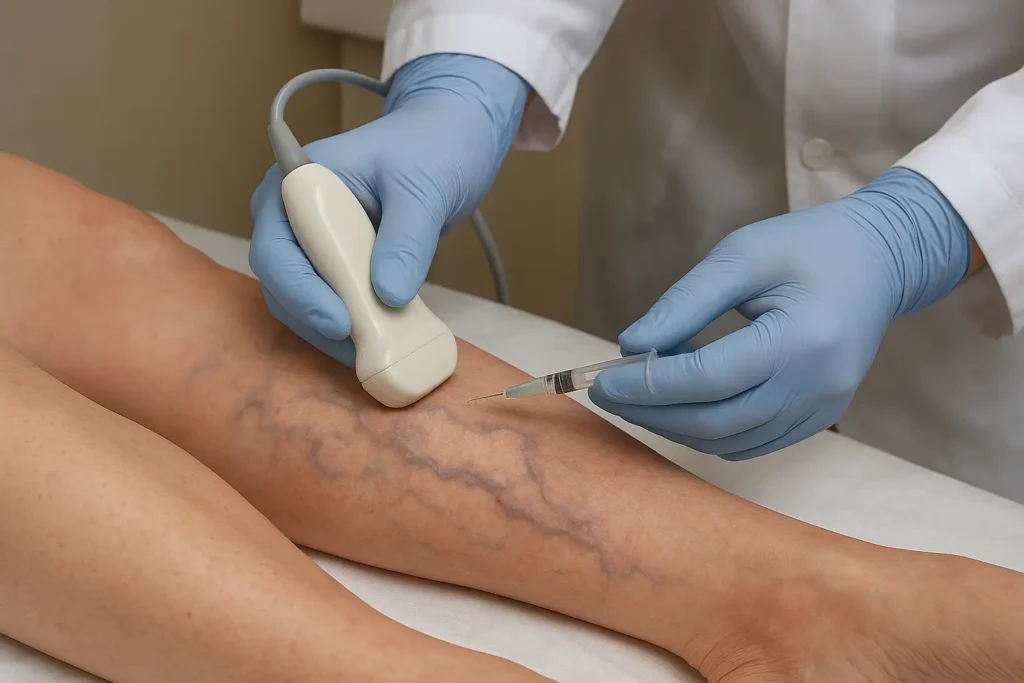Varicose Veins
Why Do Varicose Veins Worsen During Summer Heat?
Los Angeles summer weather, with its intense heat and prolonged sunny days, significantly worsens varicose veins in Los Angeles residents. The city’s consistently high temperatures and dry climate cause blood vessels to dilate, reducing circulation efficiency and exacerbating existing vein problems, making them more prominent and painful. Varicose veins become particularly problematic during heat waves when temperatures soar above 90°F, causing veins to expand and blood to pool in the legs. The Mediterranean climate’s year-round warmth means locals face ongoing challenges with venous health. Understanding how LA’s weather patterns directly contribute to vascular issues helps residents seek appropriate professional treatment for their condition.
The Science Behind Heat and Varicose Veins
When temperatures soar, your body’s circulatory system works hard to maintain a stable core temperature. Blood vessels naturally dilate in response to heat, a process called vasodilation. This biological response affects healthy veins and compromised varicose veins differently.
In healthy veins, one-way valves efficiently pump blood back to the heart against the force of gravity. However, varicose veins develop when these valves become weakened or damaged, causing blood to pool in the lower extremities. During hot weather, the combination of vessel dilation and gravity creates the perfect storm for increased venous pressure.
The expansion of already-compromised veins leads to several uncomfortable symptoms that many Los Angeles residents recognize all too well. As a vein doctor would explain, this process makes existing varicose veins more visible, swollen, and painful during the summer months.
Common Summer Symptoms of Varicose Veins
Patients seeking varicose veins treatment in Los Angeles often report these heat-related symptoms:
Physical Discomfort:
- Increased leg heaviness and fatigue
- Throbbing or burning sensations
- Muscle cramps, particularly at night
- Swelling in feet and ankles
Visual Changes:
- More prominent, bulging veins
- Darker, more noticeable discoloration
- Increased spider vein visibility
Activity-Related Issues:
- Difficulty standing for extended periods
- Discomfort during outdoor activities
- Reduced exercise tolerance
These symptoms typically intensify during the hottest parts of the day and may persist into evening hours, affecting sleep quality and daily activities.

Why Does the Los Angeles Climate Affect Vein Health?
Los Angeles’s Mediterranean climate presents unique challenges for individuals with varicose veins. The combination of year-round warm temperatures, low humidity, and intense UV exposure creates conditions that exacerbate venous insufficiency.
Extended periods of heat exposure cause sustained vasodilation, keeping veins in a constantly dilated state. Additionally, dehydration—common in hot, dry climates—reduces blood volume, making circulation less efficient. Many residents spend increased time outdoors during pleasant weather, leading to prolonged standing or walking on hard surfaces that further stress compromised veins.
A qualified vascular vein doctor understands these regional factors and can provide targeted advice for managing symptoms in Southern California’s climate.
Professional Treatment Options in Los Angeles
Modern vein treatment in Los Angeles facilities offer numerous minimally invasive procedures that effectively address varicose veins:
- Endovenous Laser Treatment (EVLT): Uses laser energy to seal problematic veins, redirecting blood flow to healthy vessels.
- Sclerotherapy: Involves injecting a solution that causes targeted veins to collapse and fade over time.
- Radiofrequency Ablation: Employs heat energy to close malfunctioning veins with minimal discomfort.
- VenaSeal Closure: Uses medical adhesive to seal affected veins without requiring heat or multiple injections.
The best varicose vein treatment in Los Angeles depends on individual factors, including vein size, location, and overall health status.
Prevention and Management Strategies
While professional treatment provides definitive solutions, several strategies can help manage summer symptoms:
- Wear compression stockings during hot weather
- Elevate legs frequently throughout the day
- Stay well-hydrated to maintain optimal blood volume
- Exercise regularly to improve circulation
- Avoid prolonged standing or sitting
- Seek shade during peak heat hours
When to Consult a Vein Specialist?
If varicose veins significantly impact your quality of life, especially during the summer months, consulting a doctor or vein specialist is recommended. Warning signs requiring immediate attention include sudden swelling, changes in skin texture, or persistent pain.
An experienced evaluation helps determine the most suitable treatment approach and prevents potential complications, such as blood clots or skin ulcers.
Take Action for Your Vein Health
Don’t let summer heat compromise your comfort and mobility. If you’re experiencing worsening varicose vein symptoms during Los Angeles’s warm months, professional evaluation and treatment can provide lasting relief.
Contact the Encino Vascular Institute today to schedule a consultation with our experienced vascular specialists. Our team uses the latest minimally invasive techniques to help you enjoy active summers without vein-related discomfort. Call now to discuss personalized treatment options and reclaim your vascular health.
FAQs
Do varicose veins always get worse in summer?
Most people with varicose veins experience increased symptoms during hot weather due to heat-induced vasodilation and increased blood pooling.
Can I exercise outdoors with varicose veins during summer?
Yes, but choose cooler times of day, wear compression garments, and stay hydrated. Swimming is particularly beneficial for circulation.
How quickly do vein treatments work?
Most modern treatments show initial results within 2-4 weeks, with continued progress over several months.
Does insurance cover varicose vein treatments?
Many insurance plans cover treatment for symptomatic varicose veins. A consultation with a vein specialist can clarify coverage options.
What’s the difference between varicose veins and spider veins?
Varicose veins are larger, deeper, and often symptomatic, while spider veins are smaller surface vessels primarily causing cosmetic concerns.